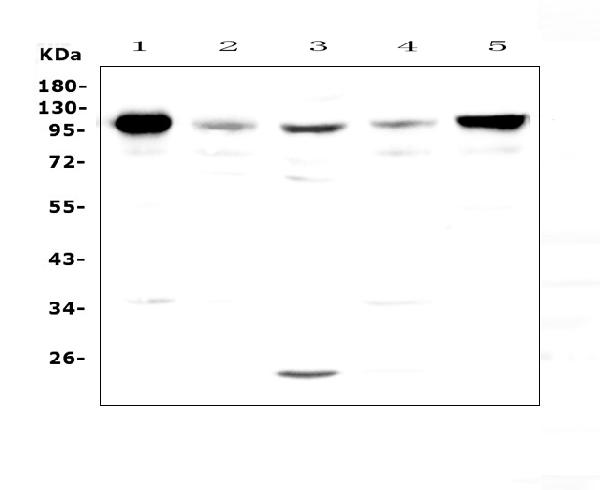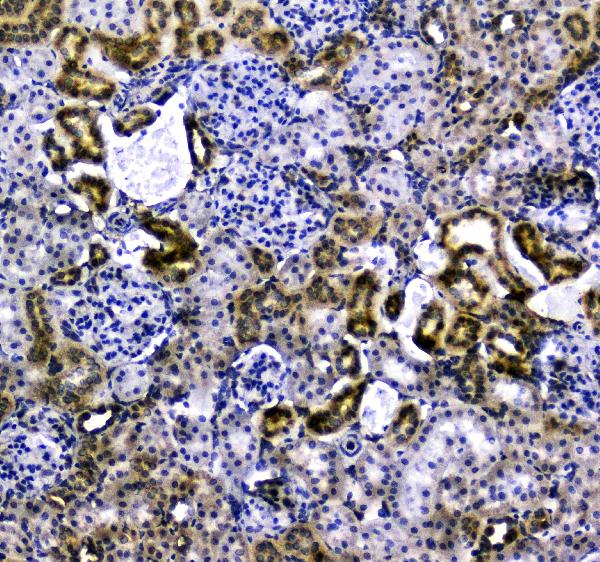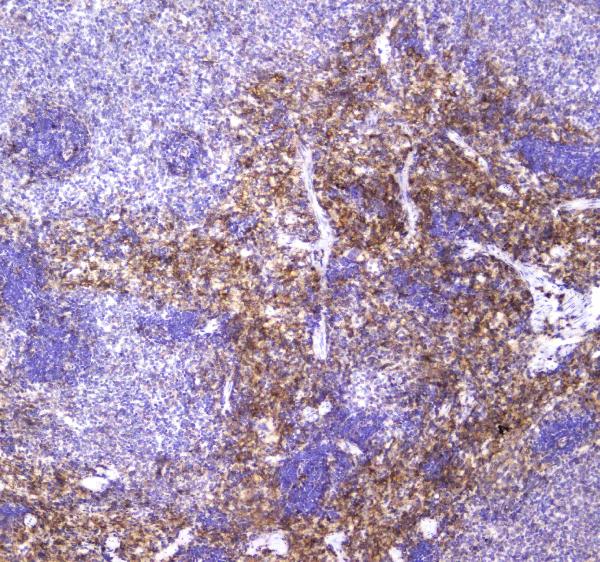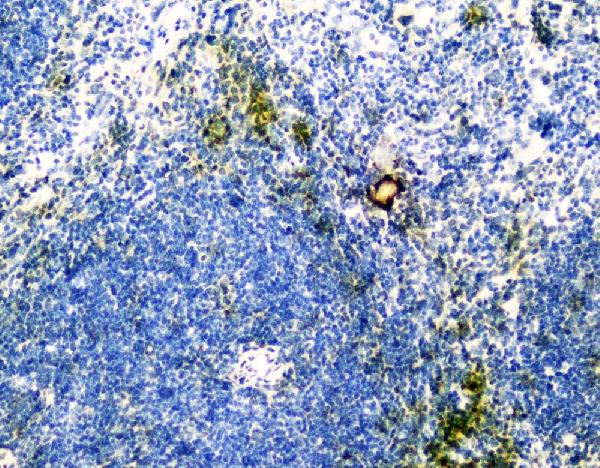Product Info Summary
| SKU: | A01199-2 |
|---|---|
| Size: | 100 μg/vial |
| Reactive Species: | Mouse, Rat |
| Host: | Rabbit |
| Application: | ELISA, IHC, WB |
Customers Who Bought This Also Bought
Product info
Product Name
Anti-VCAM1 Antibody Picoband®
View all VCAM-1/CD106 Antibodies
SKU/Catalog Number
A01199-2
Size
100 μg/vial
Form
Lyophilized
Description
Boster Bio Anti-VCAM1 Antibody Picoband® catalog # A01199-2. Tested in ELISA, IHC, WB applications. This antibody reacts with Mouse, Rat. The brand Picoband indicates this is a premium antibody that guarantees superior quality, high affinity, and strong signals with minimal background in Western blot applications. Only our best-performing antibodies are designated as Picoband, ensuring unmatched performance.
Storage & Handling
Store at -20˚C for one year from date of receipt. After reconstitution, at 4˚C for one month. It can also be aliquotted and stored frozen at -20˚C for six months. Avoid repeated freeze-thaw cycles.
Cite This Product
Anti-VCAM1 Antibody Picoband® (Boster Biological Technology, Pleasanton CA, USA, Catalog # A01199-2)
Host
Rabbit
Contents
Each vial contains 4mg Trehalose, 0.9mg NaCl, 0.2mg Na2HPO4, 0.05mg NaN3.
Clonality
Polyclonal
Isotype
Rabbit IgG
Immunogen
E. coli-derived rat VCAM1 recombinant protein (Position: F25-L270).
*Blocking peptide can be purchased. Costs vary based on immunogen length. Contact us for pricing.
Cross-reactivity
No cross-reactivity with other proteins.
Reactive Species
A01199-2 is reactive to Vcam1 in Mouse, Rat
Reconstitution
Add 0.2ml of distilled water will yield a concentration of 500ug/ml.
Observed Molecular Weight
110 kDa
Calculated molecular weight
81.276kDa
Background of VCAM-1/CD106
CD106 (cluster of differentiation 106) also known as vascular cell adhesion molecule 1 (VCAM-1), is a protein that in humans is encoded by the VCAM1 gene. In inflammatory conditions and in cardiac allografts undergoing rejection, VCAM1 is upregulated in endothelium of postcapillary venules. Arterial expression of VCAM1 is also found in experimental models of atherosclerosis in the rabbit. This gene is mapped to chromosome 1 by Southern analysis of somatic cell hybrids. VCAM-1 functions as a cell adhesion molecule. The VCAM-1 protein mediates the adhesion of lymphocytes, monocytes, eosinophils, andbasophils to vascularendothelium. It also functions in leukocyte-endothelial cell signal transduction, and it may play a role in the development ofatherosclerosis and rheumatoid arthritis. CAM741 works similar to cotransin in that it represses the biosynthesis of VCAM1 cells by blocking the process of cotranslational translocation, which is dependent on the signal peptide ofVCAM1. Among the lung metastasis signature genes identified, several, includingVCAM1, were functionally validated.
Antibody Validation
Boster validates all antibodies on WB, IHC, ICC, Immunofluorescence, and ELISA with known positive control and negative samples to ensure specificity and high affinity, including thorough antibody incubations.
Application & Images
Applications
A01199-2 is guaranteed for ELISA, IHC, WB Boster Guarantee
Assay Dilutions Recommendation
The recommendations below provide a starting point for assay optimization. The actual working concentration varies and should be decided by the user.
Western blot, 0.1-0.5μg/ml
Immunohistochemistry (Paraffin-embedded Section), 0.5-1μg/ml
ELISA, 0.1-0.5μg/ml
Positive Control
WB: rat spleen tissue, rat thymus tissue, rat testis tissue, rat kidney tissue, rat lung tissue
IHC: rat kidney tissue, rat spleen tissue, mouse spleen tissue
Validation Images & Assay Conditions

Click image to see more details
Figure 1. Western blot analysis of VCAM1 using anti-VCAM1 antibody (A01199-2).
Electrophoresis was performed on a 5-20% SDS-PAGE gel at 70V (Stacking gel) / 90V (Resolving gel) for 2-3 hours. The sample well of each lane was loaded with 50ug of sample under reducing conditions.
Lane 1: rat spleen tissue lysates,
Lane 2: rat thymus tissue lysates,
Lane 3: rat testis tissue lysates,
Lane 4: rat kidney tissue lysates,
Lane 5: rat lung tissue lysates.
After Electrophoresis, proteins were transferred to a Nitrocellulose membrane at 150mA for 50-90 minutes. Blocked the membrane with 5% Non-fat Milk/ TBS for 1.5 hour at RT. The membrane was incubated with rabbit anti-VCAM1 antigen affinity purified polyclonal antibody (Catalog # A01199-2) at 0.5 μg/mL overnight at 4°C, then washed with TBS-0.1%Tween 3 times with 5 minutes each and probed with a goat anti-rabbit IgG-HRP secondary antibody at a dilution of 1:10000 for 1.5 hour at RT. The signal is developed using an Enhanced Chemiluminescent detection (ECL) kit (Catalog # EK1002) with Tanon 5200 system. A specific band was detected for VCAM1 at approximately 110KD. The expected band size for VCAM1 is at 81KD.

Click image to see more details
Figure 2. IHC analysis of VCAM1 using anti-VCAM1 antibody (A01199-2).
VCAM1 was detected in paraffin-embedded section of rat kidney tissue. Heat mediated antigen retrieval was performed in citrate buffer (pH6, epitope retrieval solution) for 20 mins. The tissue section was blocked with 10% goat serum. The tissue section was then incubated with 1μg/ml rabbit anti-VCAM1 Antibody (A01199-2) overnight at 4°C. Biotinylated goat anti-rabbit IgG was used as secondary antibody and incubated for 30 minutes at 37°C. The tissue section was developed using Strepavidin-Biotin-Complex (SABC)(Catalog # SA1022) with DAB as the chromogen.

Click image to see more details
Figure 3. IHC analysis of VCAM1 using anti-VCAM1 antibody (A01199-2).
VCAM1 was detected in paraffin-embedded section of rat spleen tissue. Heat mediated antigen retrieval was performed in citrate buffer (pH6, epitope retrieval solution) for 20 mins. The tissue section was blocked with 10% goat serum. The tissue section was then incubated with 1μg/ml rabbit anti-VCAM1 Antibody (A01199-2) overnight at 4°C. Biotinylated goat anti-rabbit IgG was used as secondary antibody and incubated for 30 minutes at 37°C. The tissue section was developed using Strepavidin-Biotin-Complex (SABC)(Catalog # SA1022) with DAB as the chromogen.

Click image to see more details
Figure 4. IHC analysis of VCAM1 using anti-VCAM1 antibody (A01199-2).
VCAM1 was detected in paraffin-embedded section of mouse spleen tissues. Heat mediated antigen retrieval was performed in citrate buffer (pH6, epitope retrieval solution) for 20 mins. The tissue section was blocked with 10% goat serum. The tissue section was then incubated with 1μg/ml rabbit anti-VCAM1 Antibody (A01199-2) overnight at 4°C. Biotinylated goat anti-rabbit IgG was used as secondary antibody and incubated for 30 minutes at 37°C. The tissue section was developed using Strepavidin-Biotin-Complex (SABC)(Catalog # SA1022) with DAB as the chromogen.
Protein Target Info & Infographic
Gene/Protein Information For Vcam1 (Source: Uniprot.org, NCBI)
Gene Name
Vcam1
Full Name
Vascular cell adhesion protein 1
Weight
81.276kDa
Alternative Names
Vascular cell adhesion protein 1; V-CAM 1; VCAM-1; CD106; Vcam1; Vcam-1 VCAM1 CD106, INCAM-100 vascular cell adhesion molecule 1 vascular cell adhesion protein 1|CD106
*If product is indicated to react with multiple species, protein info is based on the gene entry specified above in "Species".For more info on Vcam1, check out the Vcam1 Infographic

We have 30,000+ of these available, one for each gene! Check them out.
In this infographic, you will see the following information for Vcam1: database IDs, superfamily, protein function, synonyms, molecular weight, chromosomal locations, tissues of expression, subcellular locations, post-translational modifications, and related diseases, research areas & pathways. If you want to see more information included, or would like to contribute to it and be acknowledged, please contact [email protected].
Specific Publications For Anti-VCAM1 Antibody Picoband® (A01199-2)
Hello CJ!
A01199-2 has been cited in 12 publications:
*The publications in this section are manually curated by our staff scientists. They may differ from Bioz's machine gathered results. Both are accurate. If you find a publication citing this product but is missing from this list, please let us know we will issue you a thank-you coupon.
The Neurovascular Protective Effects of Huperzine A on D-Galactose-Induced Inflammatory Damage in the Rat Hippocampus
Heme oxygenase-1 alleviates cigarette smoke-induced restenosis after vascular angioplasty by attenuating inflammation in rat model
Characterization of a novel polysaccharide from Moutan Cortex and its ameliorative effect on AGEs-induced diabetic nephropathy
High-density lipoprotein of patients with breast cancer complicated with type 2 diabetes mellitus promotes cancer cells adhesion to vascular endothelium via ICAM-1 and VCAM-1 upregulation
Lian Y,Zhu M,Chen J,Yang B,Lv Q,Wang L,Guo S,Tan X,Li C,Bu W,Ding W,Jia X,Feng L. Characterization of a novel polysaccharide from Moutan Cortex and its ameliorative effect on AGEs-induced diabetic nephropathy. Int J Biol Macromol. 2021 Feb 10:S0141-8130(2
Species: Human,Rat
A01199-2 usage in article: APP:WB, SAMPLE:KIDNEY TISSUE, DILUTION:1:200
LDL Receptor Gene-ablated Hamsters: A Rodent Model of Familial Hypercholesterolemia With Dominant Inheritance and Diet-induced Coronary Atherosclerosis
Mesenchymal stromal cells ameliorate oxidative stress-induced islet endothelium apoptosis and functional impairment via Wnt4-?-catenin signaling
Trimethylamine N-oxide in atherogenesis: impairing endothelial self-repair capacity and enhancing monocyte adhesion
Retinoic Acid Promotes Interleukin-4 Plasmid-Dimethylsulfoxide Topical Transdermal Delivery for Treatment of Psoriasis
TSP-1 Secreted by Bone Marrow Stromal Cells Contributes to Retinal Ganglion Cell Neurite Outgrowth and Survival
Recommended Resources
Here are featured tools and databases that you might find useful.
- Boster's Pathways Library
- Protein Databases
- Bioscience Research Protocol Resources
- Data Processing & Analysis Software
- Photo Editing Software
- Scientific Literature Resources
- Research Paper Management Tools
- Molecular Biology Software
- Primer Design Tools
- Bioinformatics Tools
- Phylogenetic Tree Analysis
Customer Reviews
Have you used Anti-VCAM1 Antibody Picoband®?
Submit a review and receive an Amazon gift card.
- $30 for a review with an image
0 Reviews For Anti-VCAM1 Antibody Picoband®
Customer Q&As
Have a question?
Find answers in Q&As, reviews.
Can't find your answer?
Submit your question
2 Customer Q&As for Anti-VCAM1 Antibody Picoband®
Question
A representative from Thermofisher is asking if we had testing data for WB/IHC for A01199-2 on mouse samples. Are we able to provide this?
Verified Customer
Verified customer
Asked: 2020-02-03
Answer
Please see testing image for IHC for A01199-2 on mouse sample on the product page. https://www.bosterbio.com/anti-vcam1-picoband-trade-antibody-a01199-2-boster.html?options=cart We don't have WB image on mouse sample.
Boster Scientific Support
Answered: 2020-02-03
Question
We are currently using anti-VCAM1 antibody A01199-2 for mouse tissue, and we are content with the IHC results. The species of reactivity given in the datasheet says mouse, rat. Is it likely that the antibody can work on primate tissues as well?
Verified Customer
Verified customer
Asked: 2019-06-24
Answer
The anti-VCAM1 antibody (A01199-2) has not been tested for cross reactivity specifically with primate tissues, but there is a good chance of cross reactivity. We have an innovator award program that if you test this antibody and show it works in primate you can get your next antibody for free. Please contact me if I can help you with anything.
Boster Scientific Support
Answered: 2019-06-24





